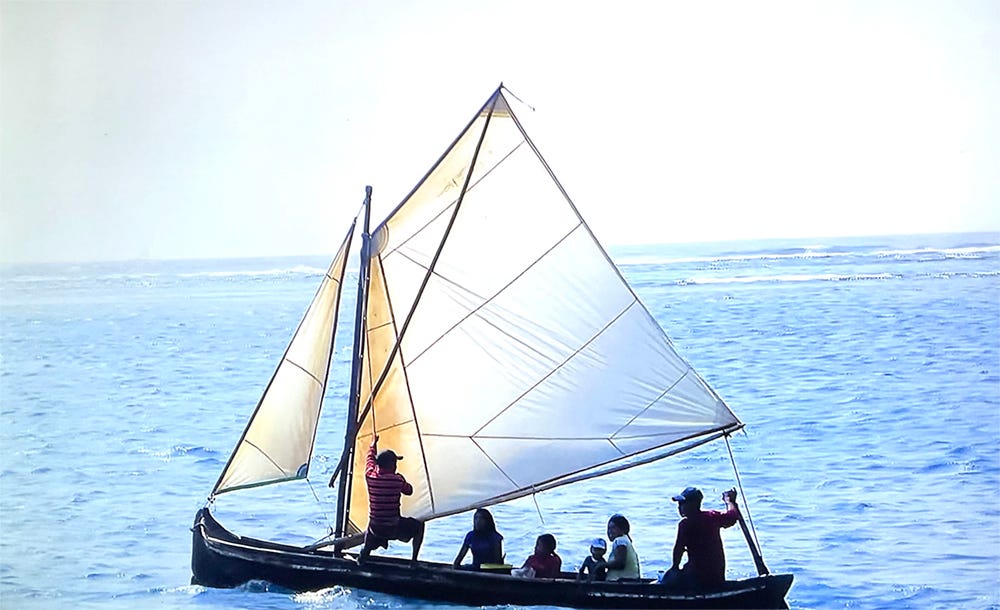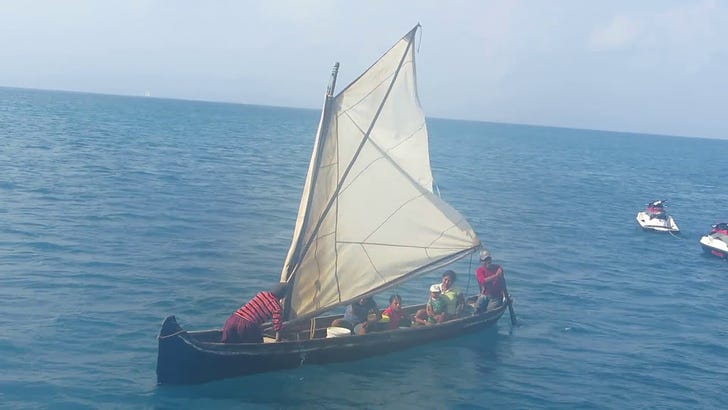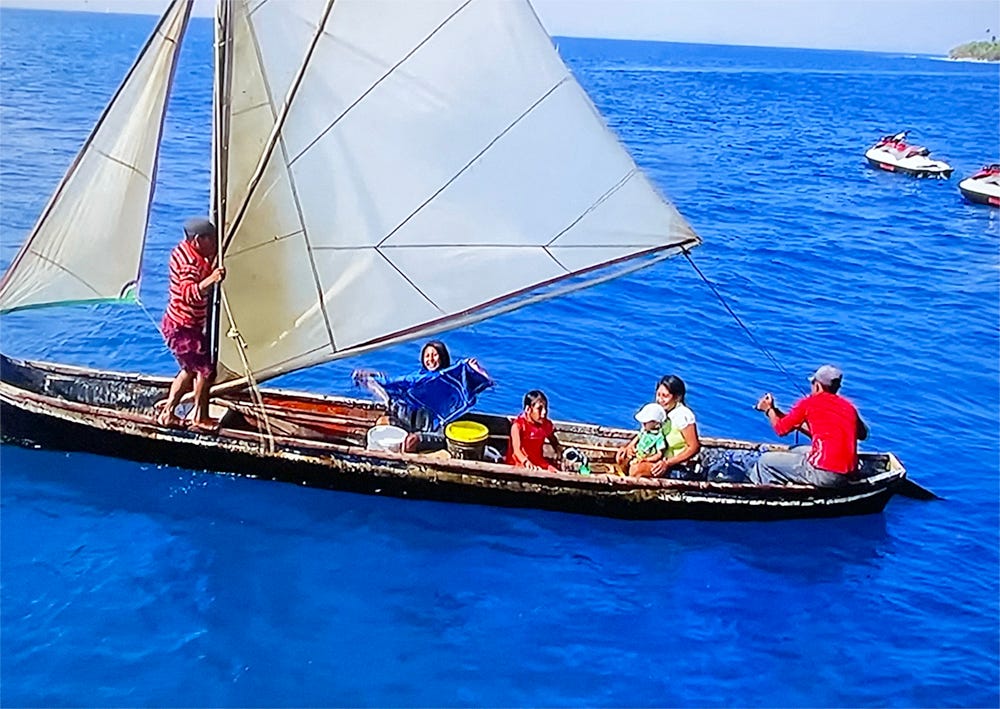I have given a great deal of thought about how to deal with the topic of sailing dugouts and I have decided to simply not try to write about the origins and first use of sails; it is both too obscure and too conjectural to be of much value.
I have witnessed archaeologists spin vast, dense clouds of conjecture and fantasy, presented as facts, about cosmology, social stratification, warfare, religious beliefs and “cultural imperatives;” all of it based on sketchy analysis of physical “evidence,” most of which goes unchallenged. I find this to be misleading, arrogant and shameful. I will try my best to avoid doing it myself.
I am a generalist and that approach has served me well. I try to use a broad perspective, an overview—metaphorically, from 20,000 feet—whenever I can I will also freely admit that on the topic of sailing dugout canoes I am engaging in a certain level (what I hope is a cautious level) of guesswork. I’ll do my best to be up front about this at all times.
I am going to focus on what I consider to be a meaningful and well-documented factual example and offer a few ideas about how people—humans—deal with new technologies by embracing them, modifying them or rejecting them.
The images used to present this example consist of a 4-minute video on YouTube made in 2013.
I urge you to look at the video, preferably several times, before reading what I have written. For those who will not or cannot see the video I will do my very best to give a clear, concise verbal description of the action. Again, please watch the video yourself and form your own opinion.
The video takes place in the San Blas islands, in the Archipelago of Bocas del Toro on the Caribbean coast of Panama. The people sailing are Cunas (Guna, Kuna) who are indigenous to Colombia and Panama. They have their own language, their own territory within Panama, their own language and an organized political structure. Their economy is based, it seems, on tourism and coconuts. In the present era of Covid I’d say that coconuts are probably a better bet than tourism—but that is just a guess.
DESCRIPTION OF ACTION
What the video shows is 6 Cuna individuals: 2 men, 2 women and 2 children in a dugout canoe about 25 feet long. One man is seated at the stern, steering with a fairly large paddle. The girl and the kids are seated amidships while the second man steps the mast, with sail already attached, rigs the boom, spreet and mainsheet (a spreet is a light spar placed across the sail diagonally, attached to the mast just above the boom and used to support the after end of the head of the sail. The rig is called a SPRIT sail, the diagonal pole/spar is called a SPREET.) This is why they say that a picture is worth a thousand words. The second man, the “crew,” is also seen bending on a small, self-tending jib—set “flying,” i.e. not attached to a stay—its luff rope simply tied to the mast head and the stem head. No shrouds, forestay or purchase (block and tackle). The flexing of the mast appears to keep luff tension for the jib. To sum up: a spritsail sloop, 25-feet-long dugout canoe with 5 people aboard, steered by a hand-held paddle.
DISCUSSION
I was first exposed to a sailing dugout in Costa Rica in the early 1970s—very briefly. In 2014 I had the chance to look closely at a few Garifuna dugouts on the beach south of Trujillo, Honduras. Their sails, sadly, were pitiful scraps of thin black plastic sheeting, not much heavier than trash bags. The Cuna dugout in the video has bright, white, well-cut sails apparently made of modern, synthetic sail cloth that appears to be expertly machine sewn. Where they came from is unknown to me. Possibly they made the sails themselves, possibly they came from tourist yachtsmen. Guess Work!
The spars of the dugout are fairly thin, slightly irregular and flexible. They appear to have been cut from saplings in the surrounding tropical forest. The absence of shrouds and a dedicated forestay makes everything very simple; the flexibility may even be helpful in terms of sail shape; the KISS principle at work in the wilds of Panama.
The jib sheet is nothing more than a short piece of line running from the jib’s clew back to the mast where it is tied off leaving just enough slack to allow the jib to come across when tacking. Both minimalist and clever. The main sheet is seen running back to the stern where it is belayed. Just where and how it is belayed is a mystery to me as an observer.
The last two pieces of the dugout’s sailing gear that I’ll draw your attention to are the very important, multi-purpose paddle and a trapeze; yes, I said a trapeze. We will get to that soon.
THE PADDLE

Do you remember when you went to Summer Camp at Lake Winipachuco, where you first learned to “J stroke?” If not, I will teach you now. The steering paddler of any canoe sits back aft. Novice canoers thrash around with the paddle, first going in one direction, then another; zigzagging as they switch the paddle from hand to hand, side to side, Port to Starboard and back again, trying to go in a straight line—because no one ever taught them how to J stroke.
It’s a safe bet that the Cuna paddler in the video never went to Summer Camp, but he is a master of the J stroke—and more. Here’s how it works: sitting back aft you position the paddle so that the broad surface of the blade is at right angles to the hull of the canoe. Then you “dig” into the water, transferring muscle energy from your back, shoulders and arms to the paddle and then on to the water, drawing/propelling the canoe forward, with you in it.
With the J stroke the same motion used to propel forward continues; as the paddle stroke ends you keep the paddle in the water and twist it so that the broad surface of the blade scribes the form of the letter J as the blade comes back to lie flat against the side, the hull, of the canoe. If you are right handed you will probably lower your right elbow and brace it to hold the paddle in place for a few seconds. As you repeat the J stroke-which can be done on either of the canoe—you find yourself quietly steering the canoe on a steady course without switching the paddle from side to side like some kind of greenhorn, city boy dude. Being quiet is often useful in boats, in this case it helps to not scare away the fish or the moose.
BACK TO THE ACTION
As the dugout passes through the “eye” of the wind the sails begin to draw, propelling her forward; there is no longer a need to use the paddle to propel her. The video clearly shows the helmsman holding the paddle upright, with just one hand, its shaft laid against the leeward side of the hull and its blade submerged. The function of the paddle has now changed.
No longer propelling the canoe with the muscle power of the paddler, the paddle has become a “lee board,” creating a center of lateral resistance, along with the submerged part of the hull, that helps to reduce “leeway” i.e., sliding sideways to leeward as the wind pushes on the sails. This is exactly the principle function of exterior keels on large racing yachts, centerboards on shoal draft coasting schooners, dagger boards on small sailing prams, and the bloody great, lifted-up-by hand-cranked-windlass lee boards on Thames River sailing barges. My guess is that the Cuna, like humans everywhere across the world, learned this principle on their own, by trial and error.
The paddle only requires one hand to hold it because the “push” of the hull wanting to slip to leeward is resisted by the “push” of the water, in opposition, against the blade of the paddle. The result is to sandwich the paddle between the hull and the water. These vectors, resulting from wind on the sails, water on the hull and paddle, are the simple and important basis of the physics of sailing; and the Cuna know it.
As the dugout goes forward under sail the paddle has yet another function. By gently twisting the blade of the paddle as it is pressed against the hull the boat can be steered. The paddle now becomes an effective, simple rudder enabled by: being given an angle by twisting having the water flowing at velocity across the surface of the blade.
REVIEW OF WHATS GOING ON WITH THE PADDLE
Paddle propels the boat when not sailing.
Paddle also steers the boat by using the J stroke.
Paddle stabilizes the boat, reduces leeway by also acting as a leeboard when sailing.
Paddle steers the boat, acting as a rudder, while sailing and while still acting as a leeboard.
All of this from one large, hand carved paddle and the Cuna paddler who “operates” it.
THE TRAPEZE
The trapeze used in the dugout did not come from the circus—its a racing dingy piece of equipment that attaches a strong, lightweight line at or near the mast head and usually terminates at the deck level in a quick-release fitting that clips onto a harness worn by the crew or solo sailor in the cockpit. The purpose of the trapeze is to counter-balance the “heeling”—the lifting of the windward side of the hull. Heeling is caused by the leverage forces of wind on sails attached to the mast-acting as a lever to raise the windward side of the hull. Watch the video !
On the dugout the trapeze is just a soft piece of 1-inch rope tied near the top of the mast and coming down to terminate in a large loop tied with a bowline. The crew—the 2nd man in the dugout, slips the loop over his head, puts it under his arms, stands on the windward gunwale, weather side, and leans outboard facing the mast. His weight is transferred by the trapeze to the mast, giving it leverage to keep the dugout upright. The Archimedean Principle of Leverage.
My guess is that the Cuna have seen this done on tourist small craft or have had it described to the. You see the same use of makeshift trapeze on Belizean slops especially when they race. The lee gunwale can be awash with the hull stabilized by two men using trapeze(s) while holding beer bottles.
So what do we make of all this evidence and conjecture? How do we understand what’s happening in the case of Tradition meeting Innovation?
First I hope that my rather tedious analysis of the interactions of hull, sails, water and paddle reveal that there is more going on than meets the eye. The dugout—primitive as it seems to be—is going to windward very well without using anodized aluminum, ball bearings, Mylar or Carbon fiber—or even a conventional rudder.
Second, the Cunas live on the coast of Panama, not on another planet. They are, one assumes, intelligent and not entirely isolated from the people, behaviors or technologies of modern society. I believe that they have adopted and adapted some elements of innovation simply because they work for the Cuna.
In this, the Cuna, I suggest maybe analogous to the Amish farmers in 21st century America who continue to use draft animal—specifically horses and mules—instead of tractors. I am not Amish but I have raised and farmed with draft horses. This wonderful experience made me aware of the existence of recently invented and fabricated agricultural technology designed and built by Amish farmers, engineers and machinists. This sophisticated equipment is specifically designed to be used in modern, low-impact, high dollar organic farming—but with the traction—the necessary pulling of the equipment across the field—still provided by draft horses and mules.
In my opinion this synthesis is a powerful example of Tradition meeting Innovation—guided by an awareness of the available resources, what is needed and what can be adapted but also guided by heritage, cultural norms and the foundational beliefs of the community—be it Amish or Cuna. Humans are amazing!
Watch the video and work on your own analysis.
Hasta la proxima!
Duncan Blair
As always all opinions expressed are mine alone
P.S. If you find yourself curious, outraged, or interested after reading this post please feel free to contact me at: traditionalsail@gmail.com.




I am a Haida canoe maker in Alaska. I find your description of the paddle's use to be accurate. I would include that it is quite effective in actively stabilizing the canoe's roll. This is especially useful when taking novices out for the first time, when they have a tendency to react inappropriately to the canoe's movement. I appreciate your article, thank you.